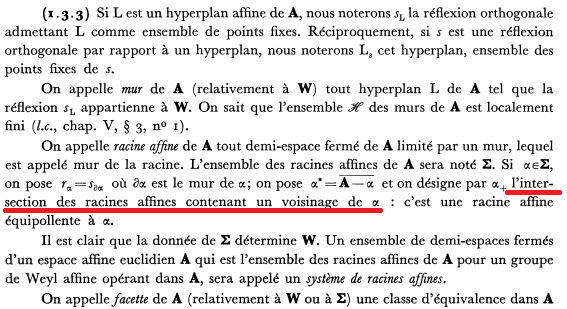I was beginning to read Bruhat and Tits article Groupes Reductifs sur un Corps Locale and was confused on a point in the beginning of the section on affine root systems.
$\mathbf{A}$ is a finite dimensional real affine space with corresponding vector space $^v\mathbf{A}$, and we are given a locally finite collection $\mathfrak H$ of hyperplanes in $\mathbf{A}$. The choice of a scalar product on $^v \mathbf{A}$ gives us a notion of orthogonality in $\mathbf{A}$. About each hyperplane $L$, we then have an orthogonal reflection $s_L$ in $\mathbf{A}$ about $L$. The group $W$ generated by all the $s_L$, with the discrete topology, is assumed to act properly on $\mathbf{A}$, and $\mathfrak H$ is assumed to be closed under the action of $W$.
In this section, they define an affine root to be a closed half space bounded by a hyperplane. If $\alpha$ is an affine root, $\alpha^{\ast}$ is apparently the other closed half space of the same wall.
Now $\alpha_+$ is defined to be the "intersection of all affine roots containing a neighborhood of $\alpha$." They then say that $\alpha_+$ is an affine root which is equipollent to $\alpha$, which means that $\alpha = \alpha_+ + v$ for some $v \in ^v \mathbf{A}$.
I don't understand what this definition of $\alpha_+$ is saying. Why should $\alpha_+$ be anything other than $\alpha$ itself? If $\alpha_+$ is different from $\alpha$, why should it also be an affine root according to the above definition, and why should it be equipollent to $\alpha$? How does this relate to the other definition of affine roots, for example in Bourbaki Chapter VI of Lie Groups and Lie Algebras?

